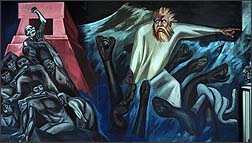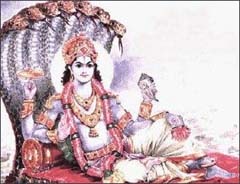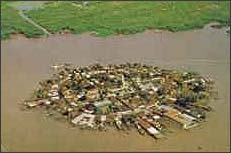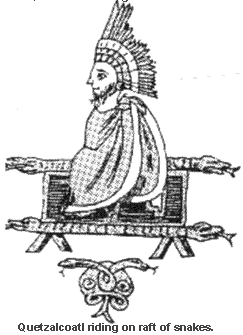|
and Give the Ancient Mexicans Their Religious Traditions?
When I was a child, my parents were, for a while, members of a Fundamentalist Christian sect called The Nazarenes. It was not a fun church. I escaped from it at age twelve, just when
puberty and interest in girls set in. Though they tried to make me stay in that church, Mom and Dad could not weaken my determination to leave it. However, I did enjoy a certain short song that all the Nazarene children had to learn by heart: Jesus Loves Me, This I know, for the Bible Tells Me So! Had I known then what I know now, I would've sung it this way: The Bible Comes From India, This I Know, for the Hindu Vedas and Puranas Tell Me So! The following account, taken from the Hindu Matsya Purana (Fish Chronicle), describes some of the people who, after a severe flood, left India for other parts of the world:
If you have read the Jewish or Christian bible, can you guess who Satyavarman, Shem, Sham, and Jyapeti were? Were Satyavarman and his sons our Noah, Shem, Ham, and Japhet? The Old Testament tells us that Satyavarman (Noah) got drunk by imbibing wine made from his vines in what is now Armenia, near Mt. Ararat. But I'm absolutely sure that my Hindu readers would know from where this story originated. In Sanskrit, Satya-Varman means "Protector of Truth; Protector of the Righteous." Varman often occurs at the end of the names of Kshatriyas (Hereditary Hindu Leadership Caste). Shem/Sem means "An Assembly." According to White racists(s), Ham was turned black as punishment for lacking in respect for his father. The Christian Fundamentalists insist that Sham fathered the Africans. It was this superstition that helped perpetuate the institution of slavery in our antebellum (pre-Civil War) South. Jyapeti became the "God of the Sun" or the Christian, Jewish, Assyrian, Greek and Roman Jupiter and Jahve or Jehovah. For the Hindus, he is Dyaus Pitar, mankind's first known manifestation of God Shiva. Satyavarman told Sham that he would acquire a name from laughter. Two of the two tribes descended from Sham were the Ha-Ha and Ho-Ho. They later migrated to other parts of the world. Ha-Ha(am)/Ham, meaning "The Ha people," were among the founders of Egypt. Other descendants of Sham, the Hohokam, settled in the American Southwest. Kam derives from the Sanskrit Gana, meaning "Tribe." Hohokam = "The Ho-Ho Tribe." Notice that both groups were desert people. Another tribe that first settled in the American Southwest were the Anazazi, known in ancient India as Anaza-zi (The Undestroyed and Living God Shiva). The Jewish Noah's Ark legend appears to be a mixture of three Hindu flood myths: Satyavarman, Vaivasvata, and Nahusha. The Mahabharata states:
Not only are the names of the main players in the Noah story the same as the family of Satyavarman, but, like the Vaivasvata part that the Old Testament authors plagiarized from the Mahabharata, the rains fell for forty days and forty nights. According to the Vaivasvata story, Shem's name is Manu; Ham or Sham is Nabhanedistha; Japhet is Yayati or Dyaus-Pitar (Jupiter or the Hebrew Jehovah). The third "Noah" was a deity named Dyaus-Nahusha. We Westerners call him Dionysius or Bacchus. Bacchus derives from the Sanskrit Bagha, meaning "God the Androgynous." When a great flood destroyed the world, Nahusha left India in order to restore civilization to mankind. He also left India for another reason which I'll relate in another part of this article. One of the places where he stopped was a small island city state called Sancha Dwipa (Sancha Island), where the citizens built their homes out of seashells.
More than twenty years ago, when I first started investigating these matters, some Fundamentalist Christians scolded me: "What can you gain by proving that all the religions and cultures of the world copied their religious traditions from the Hindus?" I answered, "Well, you're always saying that someone should go to India and save the Hindus' poor lost souls. O.K, you win. I'm doing it!"
|

Other history related articles on this site:
.
.
.
.
.
.
.
.
.
.
.
.
If you have a suggestion or history related article to submit, send it to:
Editor/viewzone.com
myristicin@hotmail.com

 "The progeny of Adamis and Hevas (Adam and Eve) soon became so wicked that they were no longer able to coexist peacefully. Brahma therefore decided to punish his
creatures "Vishnu" [right] ordered Vaivasvata to build a ship for himself and his family. When the ship was ready, and Vaivasvata and his family were inside with the seeds of every plant and a pair of every species of animal, the big rains began and the rivers began to overflow."
"The progeny of Adamis and Hevas (Adam and Eve) soon became so wicked that they were no longer able to coexist peacefully. Brahma therefore decided to punish his
creatures "Vishnu" [right] ordered Vaivasvata to build a ship for himself and his family. When the ship was ready, and Vaivasvata and his family were inside with the seeds of every plant and a pair of every species of animal, the big rains began and the rivers began to overflow." But the Mexican anomalies don't stop here.
But the Mexican anomalies don't stop here.  The pre-Aztec Toltecs were also called Nahoa and Nahua. Nahua tribes did, and still do,
extend even into South America. Since the Toltecs could not pronounce "V," I ask myself whether the words Nahoa and Nahua derive from the Sanskrit Nava, meaning "Ship; Boat."
The word "Toltec" also appears to derive from the Sanskrit word for "Descendant of the Upper World Nation": Tal-Toka. Quetzalcoatl's original homeland was Tlapallan (See my
article about
The pre-Aztec Toltecs were also called Nahoa and Nahua. Nahua tribes did, and still do,
extend even into South America. Since the Toltecs could not pronounce "V," I ask myself whether the words Nahoa and Nahua derive from the Sanskrit Nava, meaning "Ship; Boat."
The word "Toltec" also appears to derive from the Sanskrit word for "Descendant of the Upper World Nation": Tal-Toka. Quetzalcoatl's original homeland was Tlapallan (See my
article about